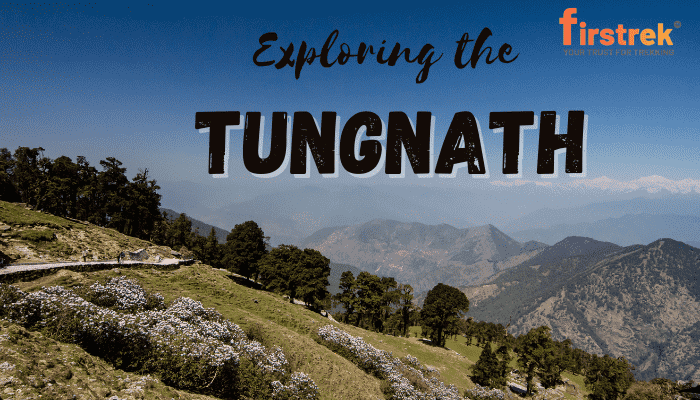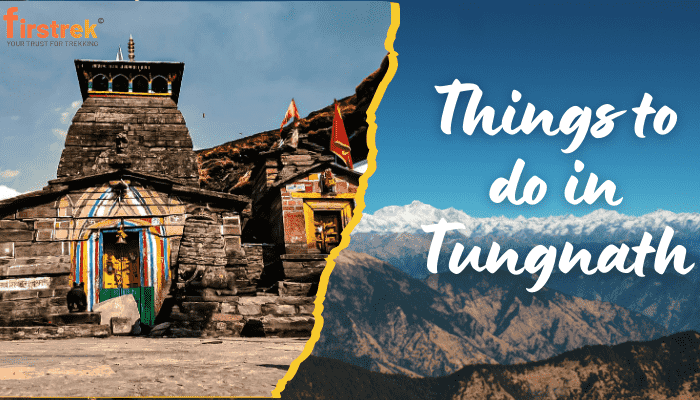
Tungnath Trekking Guide
Tungnath: The Highest Lord Shiva Temple
Tungnath, known as the highest Shiva temple in the world, is a marvel of both spirituality and natural beauty. Nestled in the Garhwal Himalayas of Uttarakhand, India, it stands at an altitude of 3,680 meters (12,073 feet). It is one of the five Panch Kedar temples, a sacred pilgrimage site for devotees of Lord Shiva. This article provides a comprehensive guide to the highest Lord Shiva Temple, its significance, how to reach it, and what to expect.
Tungnath Temple Trek: A Divine Journey
The Tungnath Trek is an exceptional journey offering adventure and spiritual fulfilment. Located in the Garhwal Himalayas of Uttarakhand, India, this trek is home to the highest Shiva temple in the world. At an elevation of 3,680 meters, it is one of the Panch Kedar temples and is renowned for its scenic beauty and spiritual significance. This guide will give you the necessary details to make your trekking experience unforgettable.
History and Mythology
Tungnath, which means “Lord of the Peaks,” is steeped in rich history and mythology. According to legend, the Pandavas from the epic Mahabharata sought Lord Shiva’s blessings to atone for their sins. Lord Shiva, avoiding the Pandavas, took the form of a bull and submerged himself at different locations in the Himalayas. His arms appeared here, making it one of the five Kedars.
Why Visit Tungnath Temple?

The Temple is a destination that offers a unique blend of spirituality, natural beauty, and adventure. Whether you are a pilgrim seeking divine blessings, a trekker looking for an exhilarating adventure, or a nature lover wanting to immerse in the serene beauty of the Himalayas, it has something for everyone. Plan your visit to this majestic temple and experience the profound tranquility and awe-inspiring beauty that the temple has to offer.
A Divine Journey
Spiritual Importance
Visiting the temple is a divine journey that offers a unique blend of spirituality and serenity. The temple, dedicated to Lord Shiva, is a place of immense religious significance. Pilgrims from all over India visit this sacred site to seek blessings and attain inner peace. The temple’s serene atmosphere, coupled with the chanting of hymns and the ringing of bells, creates an environment that is profoundly spiritual and calming.
Meditation and Inner Peace
The tranquil surroundings of the temple provide the perfect setting for meditation and self-reflection. The high altitude and the pristine environment help visitors disconnect from the chaos of everyday life and connect with their inner selves. Many visitors find a sense of inner peace and spiritual awakening in the serene ambience of Shiva Temple.
Natural Beauty and Scenic Views
Breathtaking Landscapes
Some of the most breathtaking Himalayan scenery envelops Tungnath. The trek to the temple offers panoramic views of towering peaks, lush green meadows, and dense forests. The path is lined with vibrant rhododendron flowers during spring, adding a splash of colour to the serene surroundings. The sight of the snow-capped Himalayan peaks against the clear blue sky is truly mesmerizing.
Chandrashila Trek
Just 1.5 kilometres from the temple is the Chandrashila summit, which translates to “Moon Rock.” The trek to Chandrashila is a must-do for all visitors to Tungnath. One can enjoy a 360-degree view of the majestic Himalayan ranges from the summit, including Nanda Devi, Trishul, Kedar Peak, Bandarpunch, and Chaukhamba peaks. The sunrise view from Chandrashila is particularly spectacular and worth the early morning trek.
Adventure and Trekking
Tungnath Trek Distance
The trek is an adventure in itself. Starting from Chopta, known as the “Mini Switzerland of India,” the 3.5-kilometer trek is a moderate hike that can be completed in 3–4 hours. The well-marked trail takes you through enchanting forests and alpine meadows, offering stunning views. The sense of accomplishment upon reaching the highest Shiva temple is unmatched.
Ideal for Nature Enthusiasts
For nature enthusiasts and adventure seekers, the trek is an opportunity to immerse themselves in the pristine beauty of the Himalayas. The region is home to a diverse range of flora and fauna, including the Himalayan monal, musk deer, and various species of birds. The trek provides ample opportunities for bird watching, photography, and connecting with nature.
Tungnath Temple Opening and Closing Dates 2024
Tungnath Temple Opening Dates: 2024
Opening Ceremony and Rituals
There are elaborate ceremonies and celebrations during the temple’s opening ceremony. In 2024, the temple doors are expected to open on May 10th. This date is determined based on the auspicious occasion of Akshaya Tritiya, a significant day in the Hindu calendar. The ceremony involves the recitation of Vedic hymns and the presence of local priests and devotees. The deity, Lord Shiva, is welcomed with great reverence, and the temple premises come alive with spiritual fervour.
Ideal Time to Visit After Opening
Following the opening ceremony, the best time to visit the temple is during the summer months, from May to June. During this period, the weather is pleasant, and the trekking paths are clear, offering breathtaking views of the surrounding Himalayan peaks. Pilgrims and trekkers can experience the serene ambience of the temple and participate in daily rituals and prayers.
Tungnath Temple Closing Dates: 2024
Closing Ceremony and Rituals
The temple’s closing ceremony is equally important and is characterized by complex rituals. In 2024, the temple is expected to close on November 8th. This date coincides with the festival of Bhai Dooj, following Diwali. The deity is ceremoniously moved to Mukku Village, where it remains for the winter months. The closing rituals include special prayers and offerings, marking the end of the temple’s annual pilgrimage season.
Best Time to Visit Before Closing
The period from September to early November is ideal for visiting Tungnath Temple before it closes for the winter. The post-monsoon season provides clear skies and stunning vistas of snow-capped peaks. The trek is relatively easier, and the temple is less crowded, allowing visitors to immerse themselves in the tranquility and spirituality of the place.
Tungnath Weather

The weather varies significantly throughout the year, offering a unique experience in every season. Understanding the weather patterns is essential for planning a trip, and ensuring a safe and enjoyable journey. Here, we provide an in-depth look at Tungnath’s weather across different seasons, helping you prepare for your visit to this divine location.
Summer Season (May to June)
The summer months, from April to June, are the best time to visit the temple. The weather is nice throughout this time of year, with temperatures between 10° C and 25°C. The skies are clear, offering spectacular views of the surrounding Himalayan peaks. The trekking paths are accessible, and the region is adorned with blooming rhododendrons and lush greenery, making it an ideal time for trekking and pilgrimage.
Monsoon Season (July to August)
The monsoon season lasts from July to September, bringing heavy rainfall to the region. This period sees temperatures between 10° C and 20°C. The heavy rains make the trekking paths slippery and prone to landslides, posing significant risks to travellers. It is generally advised to avoid visiting the temple during the monsoon season due to the challenging weather conditions and reduced accessibility.
Autumn Season (September to November)
Autumn is another excellent time to visit the temple, particularly from October to early November. The weather during this period is cool and pleasant, with temperatures ranging from 5° C to 20°C. The skies are clear, providing stunning views of the snow-capped Himalayan peaks. The post-monsoon season ensures that the trekking paths are dry and safe, making it a favourable time for trekking and exploring the region.
Winter Season (December to March)
The winter months from December to March bring heavy snowfall, with temperatures dropping to as low as -10 °C. The temple remains closed during this period, and the trekking paths are covered in snow, making them inaccessible. The harsh weather conditions and extreme cold make it impossible to visit the temple during the winter season.
Tungnath Temple is a destination that offers a unique blend of spirituality, natural beauty, and adventure. Understanding the weather and accessibility of the temple is essential for planning a safe and enjoyable visit. Whether you are a pilgrim seeking divine blessings, a trekker looking for an exhilarating adventure, or a nature lover wanting to immerse in the serene beauty of the Himalayas, the temple has something for everyone.
Tungnath Weather in July
For those planning a visit, understanding the weather patterns in July is crucial for a safe and enjoyable trip. Here, we provide a comprehensive guide on what to expect from Tungnath’s weather in July and how to prepare for it.
Temperature
Despite the rain, temperatures in Tungnath during July remain relatively cool. Daytime temperatures typically range from 10 °C to 15 °C (50 °F to 59 °F), while nighttime temperatures can drop to around 5 °C to 10 °C (41 °F to 50 °F). The cool temperatures combined with the high humidity can make the weather feel quite chilly, especially during the early mornings and late evenings.
Trekking Conditions
Trekking in July requires careful planning and preparation due to the challenging trail conditions. The rain makes the paths slippery and prone to landslides, which can be hazardous. Trekkers must be equipped with proper gear, including waterproof clothing, sturdy trekking shoes, and trekking poles for better stability. It is also advisable to hire local guides who are familiar with the terrain and can navigate safely.
Things to do in Tungnath

This divine destination, home to the highest Shiva temple in the world, offers a unique blend of spiritual tranquility and thrilling activities. Here’s a comprehensive guide on things to do that will help you make the most of your visit to this mystical locale.
Trek to the Temple
The Tungnath Temple Trek is undoubtedly the highlight of any visit. Starting from Chopta, this 3.5-kilometer trek takes you through picturesque meadows, dense forests, and panoramic views of the Himalayan peaks. The trek is moderately challenging, making it accessible to both seasoned trekkers and beginners. As you ascend, you’ll be treated to the sights of blooming rhododendrons and diverse wildlife. Upon reaching the temple, the sense of accomplishment is immense, and the spiritual aura of the temple provides a serene experience.
Chandrashila Summit
For those seeking a more rigorous adventure, the Chandrashila Summit awaits. This additional 1.5-kilometer trek from the Tungnath Temple is a must-do. At an altitude of approximately 4,000 meters, Chandrashila offers an unparalleled 360-degree view of the Himalayas, including peaks like Nanda Devi, Trishul, and Chaukhamba. The summit is a perfect spot for photography enthusiasts and nature lovers. The panoramic views, especially at sunrise, are truly awe-inspiring and worth the effort.
Bird Watching
The region around Tungnath and Chopta is a paradise for bird watchers. With over 240 species of birds, including Himalayan monals, griffon vultures, and golden eagles, this area offers ample opportunities for bird photography and observation. The best time for bird watching is during the early mornings and late afternoons, when birds are most active. Equip yourself with a good pair of binoculars and a field guide to make the most of this experience.
Exploring Deoria Tal
From Chopta, a quick drive and hike will lead you to the peaceful Deoria Tal, a crystal-clear lake surrounded by dense forest. A captivating sight is created when the shimmering lake waters reflect the Chaukhamba peaks. For camping, taking pictures, or just relaxing in the lap of nature, Deoria Tal is the perfect location. The serene nature of the lake and the surrounding area make it the ideal getaway from the daily grind.
Accommodations and Facilities
While planning a visit to this divine location, it’s essential to know about the accommodations and facilities available. Here, we provide a detailed guide on where to stay, what to expect, and how to make the most of your stay in Chopta.
Camping in Chopta
Chopta, the starting point of the Tungnath trek, is a great place to camp. Nestled amidst verdant meadows and dense forests, Chopta provides an unparalleled camping experience that cannot be found elsewhere. Unhindered stargazing is possible thanks to the clear sky. Campers can take part in storytelling, eat local food, and have bonfires beneath the stars. Many tour companies provide amenities and camping gear to guarantee an enjoyable but relaxing stay. Operators provide camping equipment and supplies.
GMVN Tourist Rest House
The GMVN Tourist Rest House in Ukhimath offers decent accommodations at a fair price with good amenities. This guesthouse, which is managed by the Garhwal Mandal Vikas Nigam, guarantees a pleasant stay with hot water, clean rooms, and a restaurant that serves authentic Garhwali cuisine.
It’s serene landscapes and spiritual aura offers a unique blend of adventure and tranquility. Whether you prefer the comfort of a hotel or the thrill of camping, the accommodations and facilities in Tungnath cater to all preferences, ensuring a memorable and fulfilling stay.
Food and Dining
The local cuisine of Chopta primarily consists of vegetarian dishes. Traditional Garhwali food, such as aloo ke gutke (spiced potatoes), phanu (lentil soup), and mandua ki roti (millet bread), is a must-try. Most guesthouses and dhabas (roadside eateries) offer simple but delicious meals.
Tungnath Travel Tips
To make the most of your visit, follow these comprehensive travel tips, structured in five key points, to ensure a smooth, enjoyable, and enriching experience.
Packing essentials include layered clothing, waterproof trekking boots, trekking poles, a first aid kit, and hydration supplies. Layered clothing helps manage fluctuating temperatures while trekking poles aid in stability.
Acclimatization and physical fitness are vital for a successful trek. Spend a day or two in Chopta to adjust to the altitude and stay hydrated. Regular cardio and strength training exercises before your trip will prepare you for the physical demands of the trek.
In Chopta, lodging options vary from cosy homestays to rudimentary guesthouses. During busy times, it is best to make reservations in advance.
By following these travel tips, you can ensure a memorable and respectful visit to Chopta, immersing yourself in its spiritual and natural wonders.
Table of Contents
How can one go to that place?
To reach the site, travelers can first get to Chopta, the nearest base. From Chopta, it is a 3.5-kilometer trek to the destination. Chopta is accessible by road from major cities like Rishikesh and Haridwar.
Are there any lodging choices in the area?
Yes, there are various accommodation options in Chopta, ranging from basic guesthouses to comfortable homestays. There are also campsites for those who prefer a closer experience with nature.